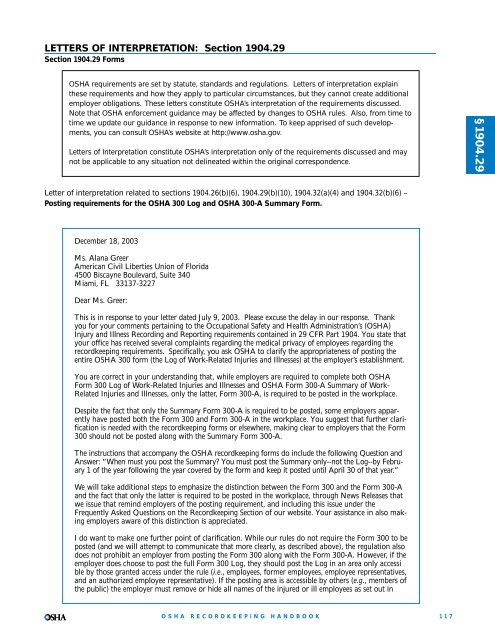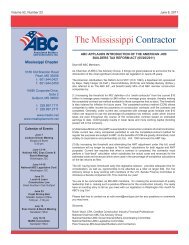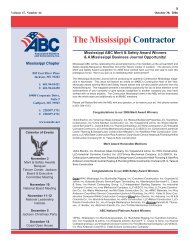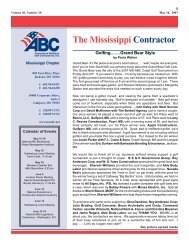OSHA Recordkeeping Handbook - Msabc.net
OSHA Recordkeeping Handbook - Msabc.net
OSHA Recordkeeping Handbook - Msabc.net
Create successful ePaper yourself
Turn your PDF publications into a flip-book with our unique Google optimized e-Paper software.
LETTERS OF INTERPRETATION: Section 1904.29Section 1904.29 Forms<strong>OSHA</strong> requirements are set by statute, standards and regulations. Letters of interpretation explainthese requirements and how they apply to particular circumstances, but they cannot create additionalemployer obligations. These letters constitute <strong>OSHA</strong>’s interpretation of the requirements discussed.Note that <strong>OSHA</strong> enforcement guidance may be affected by changes to <strong>OSHA</strong> rules. Also, from time totime we update our guidance in response to new information. To keep apprised of such developments,you can consult <strong>OSHA</strong>’s website at http://www.osha.gov.Letters of Interpretation constitute <strong>OSHA</strong>’s interpretation only of the requirements discussed and maynot be applicable to any situation not delineated within the original correspondence.§1904.29Letter of interpretation related to sections 1904.26(b)(6), 1904.29(b)(10), 1904.32(a)(4) and 1904.32(b)(6) –Posting requirements for the <strong>OSHA</strong> 300 Log and <strong>OSHA</strong> 300-A Summary Form.December 18, 2003Ms. Alana GreerAmerican Civil Liberties Union of Florida4500 Biscayne Boulevard, Suite 340Miami, FL 33137-3227Dear Ms. Greer:This is in response to your letter dated July 9, 2003. Please excuse the delay in our response. Thankyou for your comments pertaining to the Occupational Safety and Health Administration’s (<strong>OSHA</strong>)Injury and Illness Recording and Reporting requirements contained in 29 CFR Part 1904. You state thatyour office has received several complaints regarding the medical privacy of employees regarding therecordkeeping requirements. Specifically, you ask <strong>OSHA</strong> to clarify the appropriateness of posting theentire <strong>OSHA</strong> 300 form (the Log of Work-Related Injuries and Illnesses) at the employer’s establishment.You are correct in your understanding that, while employers are required to complete both <strong>OSHA</strong>Form 300 Log of Work-Related Injuries and Illnesses and <strong>OSHA</strong> Form 300-A Summary of Work-Related Injuries and Illnesses, only the latter, Form 300-A, is required to be posted in the workplace.Despite the fact that only the Summary Form 300-A is required to be posted, some employers apparentlyhave posted both the Form 300 and Form 300-A in the workplace. You suggest that further clarificationis needed with the recordkeeping forms or elsewhere, making clear to employers that the Form300 should not be posted along with the Summary Form 300-A.The instructions that accompany the <strong>OSHA</strong> recordkeeping forms do include the following Question andAnswer: “When must you post the Summary? You must post the Summary only--not the Log--by February1 of the year following the year covered by the form and keep it posted until April 30 of that year.”We will take additional steps to emphasize the distinction between the Form 300 and the Form 300-Aand the fact that only the latter is required to be posted in the workplace, through News Releases thatwe issue that remind employers of the posting requirement, and including this issue under theFrequently Asked Questions on the <strong>Recordkeeping</strong> Section of our website. Your assistance in also makingemployers aware of this distinction is appreciated.I do want to make one further point of clarification. While our rules do not require the Form 300 to beposted (and we will attempt to communicate that more clearly, as described above), the regulation alsodoes not prohibit an employer from posting the Form 300 along with the Form 300-A. However, if theemployer does choose to post the full Form 300 Log, they should post the Log in an area only accessible by those granted access under the rule (i.e., employees, former employees, employee representatives,and an authorized employee representative). If the posting area is accessible by others (e.g., members ofthe public) the employer must remove or hide all names of the injured or ill employees as set out in<strong>OSHA</strong> RECORDKEEPINGHANDBOOK117







